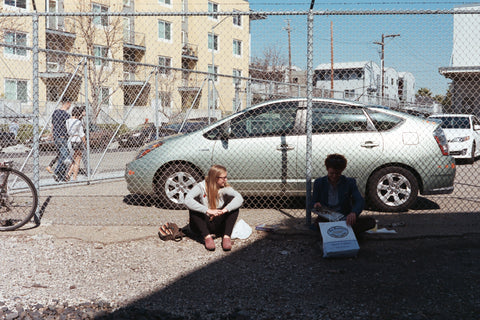Video Gear Review: Minolta CLE 35mm Film Rangefinder
MINOLTA CLE SAMPLE PHOTOS:





MINOLTA CLE SAMPLE PHOTOS:





The Minolta XE-5 is a 35mm film SLR that uses Minolta's manual focus SR mount, also commonly known as the MC mount, or simply the "Minolta mount." It is the same mount used by the famous SRT-type cameras and also the XE/XE-1/XG-7 series. The system was generally referred to as the MC system, with a whole range of compatible bodies, lenses, and accessories. First, a little about the original XE-1, which was the original in the line and the descendent of the XE-5. The XE was the first electronically controlled Minolta SLR that was targeted for advanced amateurs. It features metered manual and aperture priority shooting modes. Perhaps the most interesting part of the the XE heritage is that it is the first SLR that Minolta designed and produced in association with Leitz, the maker of Leica cameras. The XE-5 carries on most of these features, but since it is a lower end model than the original XE-1, there are some features that don't carry over. The viewfinder does not display the current aperture and shutter speed settings; there is merely a needle that shows the suggested shutter speed to which you should set the camera to depending on the your ISO and aperture setting. The focusing is achieved through a diagonal split prism.
Minolta XE-5 viewfinder
Unlike the XE-1, there is no viewfinder curtain, double exposure lever, and no safe load "flag" that shows proper film advance, although you can see the rewind lever spinning when you advance the film, telling you that the film is in fact advancing and being taken up on the take-up spool, so that's a fairly minor concern. The pentaprism housing (the SLR "bump" on top of the camera) is all black, unlike the black/chrome prism housing of the XE-1. The front panel features a self timer lever, an X-sync flash socket, a locking depth of field preview button, and the lens release button. The "Minolta" logo is engraved and painted white onto the front of the black plastic pentaprism housing. The XE-5 badge is engraved and painted black onto the upper chrome portion to the left of the Minolta logo. The grip is a stiff, slightly rubbery material. The top panel has a hot shoe, rewind crank, underneath which is the ISO dial with a locking pin (labeled "ASA"), which ranges from 12 to 3200, in 1/3 stop increments. On the same dial is the +/- exposure compensation dial, also with a locking pin, ranging from -2 to +2 in single stop increments. On the right hand side of the top panel is the shutter speed dial, including X, Bulb, and 4 seconds all the way to 1/1000th of a second in one stop increments. There is also the shutter release button with a threading for a remote release cord and the familiar film advance lever.
The rear of the camera has an on/off lever. The camera will not fire in the off position, as the shutter is electronically controlled and cannot fire without battery power. So that means dead batteries = dead camera. There is also a frame counter which goes up to 36 and stops if you have any more frames on the roll. You can still keep taking pictures, but the frame counter won't go any higher than 36. The left side profile of the camera has a tiny little lever that is easy to miss, which is a battery check lever. When you activate it, there is a red LED that lights up to let you know the battery is functioning.
One particularly convenient feature about this film camera is that it uses the very common LR44 batteries (two of them), which can be found in any grocery or drug store for very inexpensively, or online for even cheaper. You can generally buy 10 of them for just a few dollars. Many older generation cameras use battery types that are either expensive or worse, no longer available. The camera is not exactly light. While not as heavy and considered more compact than the professional level Canons and Nikons of the day, it's still larger and heavier than the similarly priced and competing Olympus OM cameras. However, it is still very comfortable in the hand. The rewind lever is nice and smooth, with a somewhat long throw distance, but still advances the frame in a single stroke. The mirror slap is nicely dampened as the entire body is nice and solid. The shutter button depresses very smoothly in one motion; it does not have a half-press function to activate metering. The camera is always metering as long as the power switch is in the "on" position.
The camera is solid feeling, and I felt very confident in its operation in the few rolls I shot with it. The lens I had for it was a bit of an odd focal length: 58mm, but it had a very nice fast aperture of f/1.4. The lens is not particularly sharp at wide open apertures but by f/2.8 it was sharp and contrasty. Because of it's somewhat long focal length, it can be susceptible to some user misfocusing at wide open apertures if you use the focus/recompose method, which can change the plane of focus, so you have to be careful with that if you're shooting fast. The camera feels really good to me, something I'd be happy to use as an everyday shooter if it was my only choice. If I had owned more lenses in the system, I would most definitely keep it, as the example I had was in very nice cosmetic shape. I certainly wish I had some wider lenses to test with it. The meter was accurate and I shot half of the roll using the built in meter, and the other half using a handheld Sekonic meter, both of which yielded fine results. Like many manual 35mm film SLRs, the appeal with this camera is the fact that you have so few choices in how you expose a picture. Shutter, aperture, and film speed--that's it. I found that this lack of choice kept me in tune with the subjects I was shooting and the shooting experience itself, and not so worried and engaged (or distracted) by the gear in my hands. I feel that the single biggest drawback this camera suffers from is that, due to it's electronically controlled shutter, it cannot be fired without batteries, like other film SLRs that can fired mechanically and only need batteries for metering (the Yashica FX-3, for example). It's construction feels hefty and durable, despite the fact that the top pentaprism housing is plastic. I would highly recommend this camera to anyone who is looking for a manual SLR, with an aperture priority mode. It certainly fetches a far lower price than Canon and Nikon models of the same level in used markets, because Minolta was simply a less popular manufacturer in the 70s and 80s, but no less of a viable option then as it is today when it comes to 35mm manual focus SLRs. Sample images below. Shot on Kodak 5279 500T color cinema film, scanned on a Pakon F135 film scanner.
Sample Image, Minolta XE-5, 58mm f/1.4, Kodak 5279 500T cinema color negative, scanned on Pakon F135 film scanner
 Sample Image, Minolta XE-5, 58mm f/1.4, Kodak 5279 500T cinema color negative, scanned on Pakon F135 film scanner
Sample Image, Minolta XE-5, 58mm f/1.4, Kodak 5279 500T cinema color negative, scanned on Pakon F135 film scanner
Sample Image, Minolta XE-5, 58mm f/1.4, Kodak 5279 500T cinema color negative, scanned on Pakon F135 film scanner
Sample Image, Minolta XE-5, 58mm f/1.4, Kodak 5279 500T cinema color negative, scanned on Pakon F135 film scanner